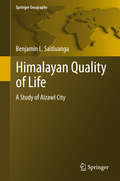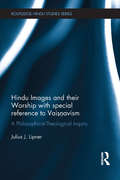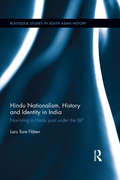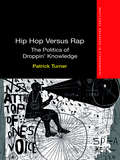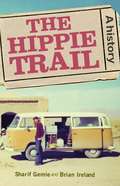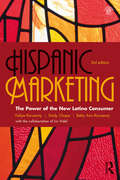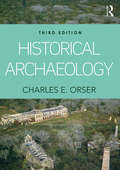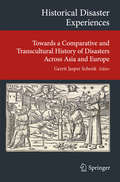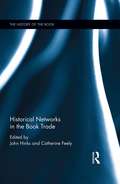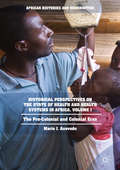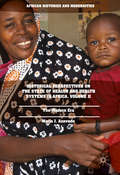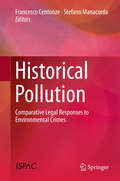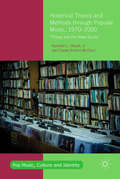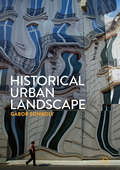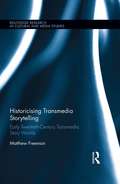- Table View
- List View
Himalayan Quality of Life: A Study of Aizawl City (Springer Geography)
by Benjamin L. SaitluangaThe book is a study of intra-urban inequality in quality of life (QOL) in Aizawl city. The main objectives of the study include analysis of processes and patterns of social differentiation along the three-dimensional space of Aizawl city as well as analysis of spatial inequality in QOL at the lowest administrative structure of the city. An investigation into spatial pattern of residential differentiation was done at both horizontal and vertical spaces. Spatial variation in well-being of residents of Aizawl city and the quality of their immediate environment was also studied by taking both objective and subjective indicators. The study employed a number of descriptive, inferential and multivariate statistical techniques including correlation, factor analysis, principal component analysis, cluster analysis and spatial autocorrelation methods like Moran’s I and Local Indicators of Spatial Association (LISA). Mapping techniques and graphical methods like Choropleth map, histogram and line graph were also used. With the help of factor analysis, the social space of Aizawl city was found to be differentiated along socio-economic status, family status, household size status, workers status and ethnic status. The most important factor determining residential differentiation was socio-economic status. Choropleth map of factor scores reveals that the inner city localities were dominated by high socio-economic class while poorer people dominated the peripheries. Non-local ethnic minorities were few but concentrated in some adjoining peripheral localities as well as in inner city localities which have been inhabited by their ancestors since the colonial period. Vertical pattern of residential differentiation was also analyzed by taking income variable as a proxy of socio-economic status. Multi-storey buildings in Aizawl city were co-inhabited by both richer people and poorer people. The richer people were found at the top floors while the poorer people occupied the basement floors. Normally, the owners of the buildings were found at the top floors while the basement floors were dominated by the renters. Spatial variation in QOL was measured with the help of principal component analysis as a weighting technique by taking variables pertaining to both objective and subjective QOL dimensions. The values of composite QOL index showed that the central localities have scored better than their peripheral counterparts. Correlation analysis of the relationship between objective indicators and subjective indicators provided a low positive value indicating the absence of relationship between the two dimensions of quality of life. Spatial autocorrelation analysis was also performed to see the pattern of clustering of spatially weighted QOL variables across Local Councils. With the help of Global Moran’s I, spatial clusters and spatial outliers were observed for objective dimension of QOL within the study area. The value of Moran’s I was found to be insignificant for subjective QOL dimension indicating the absence of significant pattern of clustering. The study also identified 7 social areas of Aizawl city on the basis of factor scores and composite scores of QOL variables calculated for all Local Councils. The identification of clusters was taken out with the help of hierarchical clustering method of cluster analysis. These clusters were labeled appropriate names and their characteristics were described in detail. The thesis concluded with recommendation of designating these social areas as ‘social development planning zones’ for obtaining inclusive development.
Hindu Images and their Worship with special reference to Vaisnavism: A philosophical-theological inquiry (Routledge Hindu Studies Series)
by Julius J. LipnerHinduism comprises perhaps the major cluster of religio-cultural traditions of India, and it can play a valuable role in helping us understand the nature of religion and human responses to life. Hindu image-worship lies at the core of what counts for Hinduism – up-front and subject to much curiosity and misunderstanding, yet it is a defining feature of this phenomenon. This book focuses on Hindu images and their worship with special reference to Vaiṣṇavism, a major strand of Hinduism. Concentrating largely, but not exclusively, on Sanskritic source material, the author shows in the course of the book that Hindu image-worship may be understood via three levels of interpretation: the metaphysical/theological, the narratival or mythic, and the performative or ritual. Analysing the chief philosophical paradigm underlying Hindu image-worship and its implications, the book exemplifies its widespread application and tackles, among other topics such as the origins of image-worship in Hinduism, the transition from Vedic to image worship, a distinguishing feature of Hindu images: their multiple heads and limbs. Finally, with a view to laying the grounds for a more positive dialogic relationship between Hinduism and the "Abrahamic" faiths, which tend to condemn Hindu image-worship as "idolatry", the author examines the theological explanation and justification for embodiment of the Deity in Hinduism and discusses how Hinduism might justify itself against such a charge. Rich in Indological detail, and with an impressive grasp of the philosophical and theological issues underlying Hindu material culture, and image-worship, this book will be of interest to academics and others studying theology, Indian philosophy and Hinduism.
Hindu Images and their Worship with special reference to Vaisnavism: A philosophical-theological inquiry (Routledge Hindu Studies Series)
by Julius J. LipnerHinduism comprises perhaps the major cluster of religio-cultural traditions of India, and it can play a valuable role in helping us understand the nature of religion and human responses to life. Hindu image-worship lies at the core of what counts for Hinduism – up-front and subject to much curiosity and misunderstanding, yet it is a defining feature of this phenomenon. This book focuses on Hindu images and their worship with special reference to Vaiṣṇavism, a major strand of Hinduism. Concentrating largely, but not exclusively, on Sanskritic source material, the author shows in the course of the book that Hindu image-worship may be understood via three levels of interpretation: the metaphysical/theological, the narratival or mythic, and the performative or ritual. Analysing the chief philosophical paradigm underlying Hindu image-worship and its implications, the book exemplifies its widespread application and tackles, among other topics such as the origins of image-worship in Hinduism, the transition from Vedic to image worship, a distinguishing feature of Hindu images: their multiple heads and limbs. Finally, with a view to laying the grounds for a more positive dialogic relationship between Hinduism and the "Abrahamic" faiths, which tend to condemn Hindu image-worship as "idolatry", the author examines the theological explanation and justification for embodiment of the Deity in Hinduism and discusses how Hinduism might justify itself against such a charge. Rich in Indological detail, and with an impressive grasp of the philosophical and theological issues underlying Hindu material culture, and image-worship, this book will be of interest to academics and others studying theology, Indian philosophy and Hinduism.
Hindu Nationalism, History and Identity in India: Narrating a Hindu past under the BJP (Routledge Studies in South Asian History)
by Lars Tore FlåtenWhen the Hindu nationalist Bharatiya Janata Party (BJP) assumed power in India in 1998 as the largest party of the National Democratic Alliance, it soon became evident that it prioritized educational reforms. Under BJP rule, a reorganization of the National Council of Educational Research and Training occurred, and in 2002 four new history textbooks were published. This book examines the new textbooks which were introduced, considering them to be integral to the BJP’s political agenda. It analyses the ways in which their narrative and explanatory frameworks defined and invoked Hindu identity. Employing the concept of decontextualization, the author argues that notions of Hindu cultural similarity were conveyed, particularly as the textbooks paid scarce attention to social, geographical and temporal contexts in their approaches to Indian history. The book shows that intrinsic to the textbooks’ emphasis on similarity is a systematic backgrounding of any references to internal lines of division within the Hindu community. Through a comparison with earlier textbooks, it sheds light on the contested nature of history writing in India, especially in terms of nation building and identity construction. This issue is also highly relevant in India today due to the electoral success of the BJP in 2014, and the efforts of the Hindu nationalist organization Vishwa Hindu Parishad to construct a coherent Hinduism. Arguing that the textbooks operate according to the BJP’s ideology of Hindu cultural nationalism, this book will be of interest to academics in the field of South Asian studies, contemporary history, the uses of history, identity politics and Hindu nationalism.
Hindu Nationalism, History and Identity in India: Narrating a Hindu past under the BJP (Routledge Studies in South Asian History)
by Lars Tore FlåtenWhen the Hindu nationalist Bharatiya Janata Party (BJP) assumed power in India in 1998 as the largest party of the National Democratic Alliance, it soon became evident that it prioritized educational reforms. Under BJP rule, a reorganization of the National Council of Educational Research and Training occurred, and in 2002 four new history textbooks were published. This book examines the new textbooks which were introduced, considering them to be integral to the BJP’s political agenda. It analyses the ways in which their narrative and explanatory frameworks defined and invoked Hindu identity. Employing the concept of decontextualization, the author argues that notions of Hindu cultural similarity were conveyed, particularly as the textbooks paid scarce attention to social, geographical and temporal contexts in their approaches to Indian history. The book shows that intrinsic to the textbooks’ emphasis on similarity is a systematic backgrounding of any references to internal lines of division within the Hindu community. Through a comparison with earlier textbooks, it sheds light on the contested nature of history writing in India, especially in terms of nation building and identity construction. This issue is also highly relevant in India today due to the electoral success of the BJP in 2014, and the efforts of the Hindu nationalist organization Vishwa Hindu Parishad to construct a coherent Hinduism. Arguing that the textbooks operate according to the BJP’s ideology of Hindu cultural nationalism, this book will be of interest to academics in the field of South Asian studies, contemporary history, the uses of history, identity politics and Hindu nationalism.
Hip Hop Versus Rap: The Politics of Droppin' Knowledge (Routledge Advances in Ethnography)
by Patrick Turner'What is the real hip hop?' 'To whom does hip hop belong?' 'For what constructive purposes can hip hop be put to use?' These are three key questions posed by hip hop activists in Hip Hop Versus Rap, which explores the politics of cultural authenticity, ownership, and uplift in London’s post-hip hop scene. The book is an ethnographic study of the identity, role, formation, and practices of the organic intellectuals that populate and propagate this ‘conscious’ hip hop milieu. Turner provides an insightful examination of the work of artists and practitioners who use hip hop ‘off-street’ in the spheres of youth work, education, and theatre to raise consciousness and to develop artistic and personal skills. Hip Hop Versus Rap seeks to portray how cultural activism, which styles itself grassroots and mature, is framed around a discursive opposition between what is authentic and ethical in hip hop culture and what is counterfeit and corrupt. Turner identifies that this play of difference, framed as an ethical schism, also presents hip hop’s organic intellectuals with a narrative that enables them to align their insurgent values with those of policy and to thereby receive institutional support. This enlightening volume will be of interest to post-graduates and scholars interested in hip hop studies; youth work; critical pedagogy; young people and crime/justice; the politics of race/racism; the politics of youth/education; urban governance; social movement studies; street culture studies; and vernacular studies.
Hip Hop Versus Rap: The Politics of Droppin' Knowledge (Routledge Advances in Ethnography)
by Patrick Turner'What is the real hip hop?' 'To whom does hip hop belong?' 'For what constructive purposes can hip hop be put to use?' These are three key questions posed by hip hop activists in Hip Hop Versus Rap, which explores the politics of cultural authenticity, ownership, and uplift in London’s post-hip hop scene. The book is an ethnographic study of the identity, role, formation, and practices of the organic intellectuals that populate and propagate this ‘conscious’ hip hop milieu. Turner provides an insightful examination of the work of artists and practitioners who use hip hop ‘off-street’ in the spheres of youth work, education, and theatre to raise consciousness and to develop artistic and personal skills. Hip Hop Versus Rap seeks to portray how cultural activism, which styles itself grassroots and mature, is framed around a discursive opposition between what is authentic and ethical in hip hop culture and what is counterfeit and corrupt. Turner identifies that this play of difference, framed as an ethical schism, also presents hip hop’s organic intellectuals with a narrative that enables them to align their insurgent values with those of policy and to thereby receive institutional support. This enlightening volume will be of interest to post-graduates and scholars interested in hip hop studies; youth work; critical pedagogy; young people and crime/justice; the politics of race/racism; the politics of youth/education; urban governance; social movement studies; street culture studies; and vernacular studies.
The hippie trail: A history (Manchester University Press Ser. (PDF))
by Sharif Gemie Brian IrelandTracing the history of the Hippie Trail and those who followed it, this book explores the motivations and experiences of these young travellers, mapping their everyday interactions with locals and the joys and hardships of independent budget travel.
Hispanic Marketing: The Power of the New Latino Consumer
by Felipe Korzenny Sindy Chapa Betty Ann KorzennyHispanic Marketing: The Power of the New Latino Consumer?focuses on using cultural insights to connect with Latino consumers. Now in its third edition, the book provides marketers with the skills necessary to perform useful Hispanic market analysis and thus develop effective integrated marketing communication strategies. Brought to you by three leaders in the field of Hispanic Marketing, this third edition now includes: ????????twenty-seven new case studies which emphasize digital marketing applications ????????theories and discussions on recent changes to Hispanic culture and society ????????concepts of social identity, motivation, cognitive learning, acculturation, technology adaptation and the influence of word of mouth in relation to the Hispanic market ????????a brand new companion website for course instructors with PowerPoint slides, videos, testbank questions and assignment examples Replete with marketing strategies that tap into the passion of Hispanic consumers, this book is the perfect companion for anyone specializing in Hispanic marketing who aims to build a meaningful connection between their brand and target markets.
Hispanic Marketing: The Power of the New Latino Consumer
by Felipe Korzenny Sindy Chapa Betty Ann KorzennyHispanic Marketing: The Power of the New Latino Consumer?focuses on using cultural insights to connect with Latino consumers. Now in its third edition, the book provides marketers with the skills necessary to perform useful Hispanic market analysis and thus develop effective integrated marketing communication strategies. Brought to you by three leaders in the field of Hispanic Marketing, this third edition now includes: ????????twenty-seven new case studies which emphasize digital marketing applications ????????theories and discussions on recent changes to Hispanic culture and society ????????concepts of social identity, motivation, cognitive learning, acculturation, technology adaptation and the influence of word of mouth in relation to the Hispanic market ????????a brand new companion website for course instructors with PowerPoint slides, videos, testbank questions and assignment examples Replete with marketing strategies that tap into the passion of Hispanic consumers, this book is the perfect companion for anyone specializing in Hispanic marketing who aims to build a meaningful connection between their brand and target markets.
Historical Archaeology
by Charles E. Orser Jr.This book provides a short, readable introduction to historical archaeology, which focuses on modern history in all its fascinating regional, cultural, and ethnic diversity. Accessibly covering key methods and concepts, including fundamental theories and principles, the history of the field, and basic definitions, Historical Archaeology also includes a practical look at career prospects for interested readers. Orser discusses central topics of archaeological research such as time and space, survey and excavation methods, and analytical techniques, encouraging readers to consider the possible meanings of artifacts. Drawing on the author’s extensive experience as an historical archaeologist, the book’s perspective ranges from the local to the global in order to demonstrate the real importance of this subject to our understanding of the world in which we live today. The third edition of this popular textbook has been significantly revised and expanded to reflect recent developments and discoveries in this exciting area of study. Each chapter includes updated case studies which demonstrate the research conducted by professional historical archaeologists. With its engaging approach to the subject, Historical Archaeology continues to be an ideal resource for readers who wish to be introduced to this rapidly expanding global field.
Historical Archaeology
by Charles E. Orser Jr.This book provides a short, readable introduction to historical archaeology, which focuses on modern history in all its fascinating regional, cultural, and ethnic diversity. Accessibly covering key methods and concepts, including fundamental theories and principles, the history of the field, and basic definitions, Historical Archaeology also includes a practical look at career prospects for interested readers. Orser discusses central topics of archaeological research such as time and space, survey and excavation methods, and analytical techniques, encouraging readers to consider the possible meanings of artifacts. Drawing on the author’s extensive experience as an historical archaeologist, the book’s perspective ranges from the local to the global in order to demonstrate the real importance of this subject to our understanding of the world in which we live today. The third edition of this popular textbook has been significantly revised and expanded to reflect recent developments and discoveries in this exciting area of study. Each chapter includes updated case studies which demonstrate the research conducted by professional historical archaeologists. With its engaging approach to the subject, Historical Archaeology continues to be an ideal resource for readers who wish to be introduced to this rapidly expanding global field.
Historical Disaster Experiences: Towards a Comparative and Transcultural History of Disasters Across Asia and Europe (Transcultural Research – Heidelberg Studies on Asia and Europe in a Global Context)
by Gerrit Jasper SchenkHistorical disaster research is still a young field. This book discusses the experiences of natural disasters in different cultures, from Europe across the Near East to Asia. It focuses on the pre-industrial era and on the question of similarities, differences and transcultural dynamics in the cultural handling of natural disasters. Which long-lasting cultural patterns of perception, interpretation and handling of disasters can be determined? Have specific types of disasters changed the affected societies? What have people learned from disasters and what not? What adaptation and coping strategies existed? Which natural, societal and economic parameters play a part? The book not only reveals the historical depth of present practices, but also reveals possible comparisons that show globalization processes, entanglements and exchanges of ideas and practices in pre-modern times.
Historical Networks in the Book Trade (The History of the Book)
by John Hinks Catherine FeelyThe book trade historically tended to operate in a spirit of co-operation as well as competition. Networks between printers, publishers, booksellers and related trades existed at local, regional, national and international levels and were a vital part of the business of books for several centuries. This collection of essays examines many aspects of the history of book-trade networks, in response to the recent ‘spatial turn’ in history and other disciplines. Contributors come from various backgrounds including history, sociology, business studies and English literature. The essays in Part One introduce the relevance to book-trade history of network theory and techniques, while Part Two is a series of case studies ranging chronologically from the Middle Ages to the twentieth century. Topics include the movement of early medieval manuscript books, the publication of Shakespeare, the distribution of seventeenth-century political pamphlets in Utrecht and Exeter, book-trade networks before 1750 in the English East Midlands, the itinerant book trade in northern France in the late eighteenth century, how an Australian newspaper helped to create the Scottish public sphere, the networks of the Belgian publisher Murquardt, and transatlantic radical book-trade networks in the early twentieth century.
Historical Networks in the Book Trade (The History of the Book)
The book trade historically tended to operate in a spirit of co-operation as well as competition. Networks between printers, publishers, booksellers and related trades existed at local, regional, national and international levels and were a vital part of the business of books for several centuries. This collection of essays examines many aspects of the history of book-trade networks, in response to the recent ‘spatial turn’ in history and other disciplines. Contributors come from various backgrounds including history, sociology, business studies and English literature. The essays in Part One introduce the relevance to book-trade history of network theory and techniques, while Part Two is a series of case studies ranging chronologically from the Middle Ages to the twentieth century. Topics include the movement of early medieval manuscript books, the publication of Shakespeare, the distribution of seventeenth-century political pamphlets in Utrecht and Exeter, book-trade networks before 1750 in the English East Midlands, the itinerant book trade in northern France in the late eighteenth century, how an Australian newspaper helped to create the Scottish public sphere, the networks of the Belgian publisher Murquardt, and transatlantic radical book-trade networks in the early twentieth century.
Historical Perspectives on the State of Health and Health Systems in Africa, Volume I: The Pre-Colonial and Colonial Eras
by Mario J. AzevedoThis book examines the historical and current state of health and the health of the African people, including the Arab North, impacted by such factors as geography and natural elements, cultural and colonial traditions, and competing biomedical and traditional systems. It also looks at technological advances, poverty and health disparities, utilization of resources, and international presence, as reflected by the work of the World Health Organization, and structural adjustments imposed by the IMF and the World Bank.
Historical Perspectives on the State of Health and Health Systems in Africa, Volume I: The Pre-Colonial and Colonial Eras
by Mario J. AzevedoThis book examines the historical and current state of health and the health of the African people, including the Arab North, impacted by such factors as geography and natural elements, cultural and colonial traditions, and competing biomedical and traditional systems. It also looks at technological advances, poverty and health disparities, utilization of resources, and international presence, as reflected by the work of the World Health Organization, and structural adjustments imposed by the IMF and the World Bank.
Historical Perspectives on the State of Health and Health Systems in Africa, Volume II: The Modern Era
by Mario J. AzevedoThis book focuses on Africa’s challenges, achievements, and failures over the past several centuries using an interdisciplinary approach that combines theory and fact and evidence-based practices and interventions in public health, and argues that most of the health problems in Africa are not a result of scarce or lack of resources, but of the misconceived and misplaced priorities that have left the continent behind every other on the globe in terms of health, education, and equitable distribution of opportunities and access to (quality) health as agreed by the United Nations member states at Alma-Ata in 1978.
Historical Perspectives on the State of Health and Health Systems in Africa, Volume II: The Modern Era
by Mario J. AzevedoThis book focuses on Africa’s challenges, achievements, and failures over the past several centuries using an interdisciplinary approach that combines theory and fact and evidence-based practices and interventions in public health, and argues that most of the health problems in Africa are not a result of scarce or lack of resources, but of the misconceived and misplaced priorities that have left the continent behind every other on the globe in terms of health, education, and equitable distribution of opportunities and access to (quality) health as agreed by the United Nations member states at Alma-Ata in 1978.
Historical Pollution: Comparative Legal Responses to Environmental Crimes
by Francesco Centonze Stefano ManacordaThis volume examines legal matters regarding the prevention and fighting of historical pollution caused by industrial emissions. "Historical pollution" refers to the long-term or delayed onset effects of environmental crimes such as groundwater or soil pollution. Historical Pollution presents and compares national legal approaches, including the most interesting and effective mechanisms for managing environmental problems in relation with historical pollution. It features interdisciplinary and international comparisons of traditional and alternative justice mechanisms.This book will be of interest to researchers in criminology and criminal justice and related areas, such as politics, law, and economics, those in the public and private sectors dealing with environmental protection, including international institutions, corporations, specialized national agencies, those involved in the criminal justice system, and policymakers.
Historical Theory and Methods through Popular Music, 1970–2000: “Those are the New Saints” (Pop Music, Culture and Identity)
by Daniel Robert Mcclure Kenneth L. Shonk Jr.This book examines the post-1960s era of popular music in the Anglo-Black Atlantic through the prism of historical theory and methods. By using a series of case studies, this book mobilizes historical theory and methods to underline different expressions of alternative music functioning within a mainstream musical industry. Each chapter highlights a particular theory or method while simultaneously weaving it through a genre of music expressing a notion of alternativity—an explicit positioning of one’s expression outside and counter to the mainstream. Historical Theory and Methods through Popular Music seeks to fill a gap in current scholarship by offering a collection written specifically for the pedagogical and theoretical needs of those interested in the topic.
Historical Urban Landscape
by Gábor SonkolyThis book uses the Historic Urban Landscape - the most recently codified notion of international urban heritage conservation - to demonstrate why it is necessary to demarcate history from cultural heritage and what consequences the increasing popularity of the latter have on history. It also demonstrates how the history of cultural heritage can be constructed as a historical problem. First, the conceptual history of urban heritage preservation – based on the standard setting instruments of international organizations – reveals the fundamental elements of the current concept of urban heritage. Second, this concept, as worded in the HUL approach, is investigated through the analysis of Vienna, which played a crucial role in the establishment of HUL. These examples are used to to show how the evolution of cultural heritage can be constructed as a historical problem.
Historical Urban Landscape
by Gábor SonkolyThis book uses the Historic Urban Landscape - the most recently codified notion of international urban heritage conservation - to demonstrate why it is necessary to demarcate history from cultural heritage and what consequences the increasing popularity of the latter have on history. It also demonstrates how the history of cultural heritage can be constructed as a historical problem. First, the conceptual history of urban heritage preservation – based on the standard setting instruments of international organizations – reveals the fundamental elements of the current concept of urban heritage. Second, this concept, as worded in the HUL approach, is investigated through the analysis of Vienna, which played a crucial role in the establishment of HUL. These examples are used to to show how the evolution of cultural heritage can be constructed as a historical problem.
Historicising Transmedia Storytelling: Early Twentieth-Century Transmedia Story Worlds (Routledge Research in Cultural and Media Studies)
by Matthew FreemanTracing the industrial emergence of transmedia storytelling—typically branded a product of the contemporary digital media landscape—this book provides a historicised intervention into understandings of how fictional stories flow across multiple media forms. Through studies of the storyworlds constructed for The Wizard of Oz, Tarzan, and Superman, the book reveals how new developments in advertising, licensing, and governmental policy across the twentieth century enabled historical systems of transmedia storytelling to emerge, thereby providing a valuable contribution to the growing field of transmedia studies as well as to understandings of media convergence, popular culture, and historical media industries.
Historicising Transmedia Storytelling: Early Twentieth-Century Transmedia Story Worlds (Routledge Research in Cultural and Media Studies)
by Matthew FreemanTracing the industrial emergence of transmedia storytelling—typically branded a product of the contemporary digital media landscape—this book provides a historicised intervention into understandings of how fictional stories flow across multiple media forms. Through studies of the storyworlds constructed for The Wizard of Oz, Tarzan, and Superman, the book reveals how new developments in advertising, licensing, and governmental policy across the twentieth century enabled historical systems of transmedia storytelling to emerge, thereby providing a valuable contribution to the growing field of transmedia studies as well as to understandings of media convergence, popular culture, and historical media industries.
